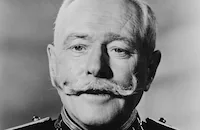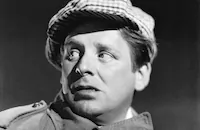Coroner Creek

Brief Synopsis
Cast & Crew
Ray Enright
Randolph Scott
Marguerite Chapman
George Macready
Sally Eilers
Edgar Buchanan
Film Details
Technical Specs

Synopsis
In a remote canyon in the Southwest, a group of renegade Apache Indians under the leadership of a mysterious white man hold up a stagecoach and kill all but one of its passengers. When cowboy Chris Danning learns that his fiancée was abducted by the leader of the gang and that she killed herself while in captivity, he vows revenge. After interviewing one of the Indians involved in the massacre and getting a description of the leader, Chris begins his manhunt. Intent on killing the outlaw, Chris searches for him at every stage and freight line office in the region. Soon after arriving in the small town of Coroner Creek, Chris meets hotel owner Kate Hardison. Because Chris is a stranger in town and does not know rancher Younger Miles, Kate entrusts him to discreetly deliver Younger's drunken wife Abbie to her home at the Rainbow Ranch. En route to the ranch, however, Chris is ambushed and given a beating by Younger's gunmen. The gunmen cease their attack when Chris explains his business with Abbie, and, one of them, Ernie Combs, offers Chris a job at the Rainbow Ranch, but Chris refuses. Later, at a Coroner Creek saloon, Chris meets Younger and notices that the ranch owner fits the description of the outlaw fugitive he is seeking. Chris tries to provoke a fight with Younger, but just as the two are about to exchange punches, Abbie's father, Sheriff O'Hea, enters the saloon and forces them apart. Chris then returns to his hotel room, where widowed ranch owner Della Harms tries to enlist his help in preventing Younger from taking her land. Chris accepts the offer to be Della's ranch foreman and immediately moves onto her ranch. A short time later, Chris is caught trespassing on Younger's ranch and is given a severe beating by Ernie. Ernie continues to pummel Chris in an unfair fight until Chris's pal, Andy West, comes to his aide. After breaking Ernie's hand, Chris points his gun at Della's ranch hand, Frank Yordy, and forces him to confess that he is in league with Younger. When Yordy tells Chris about Younger's plan to steal Della's cattle, Chris tries to foil the plan by scaring Younger with gunfire. Kate, who has fallen in love with Chris, urges him to end his feud with Younger, but Chris is determined to continue the fight. Younger, undaunted by Chris's attempt to intimidate him, sets fire to the canyon near Della's ranch, killing all her cattle. When Younger and his men kill Andy and the sheriff, Chris chases after Younger and resolves to kill him. The two men engage in a struggle, during which Younger falls to his death. Satisfied that justice has been served, Chris turns his attentions to Kate, and the two look forward to a happy future together.

Director
Ray Enright
Cast

Randolph Scott

Marguerite Chapman

George Macready

Sally Eilers

Edgar Buchanan
Barbara Reed

Wallace Ford

Forrest Tucker

Joe Sawyer
William Bishop
Russell Simpson

Douglas Fowley
Lee Bennett
Forrest Taylor
Phil Schumacher
Warren Jackson
Dewey Robinson
Crew
Harry Joe Brown
David Chudnow
William R. Fox
Kenneth Gamet
Gar Gilbert
Lee Greenway
Fred H. Jackman Jr.
Harvey Manger
Joe Popkin
Aaron Rosenberg
George Sawley
Rudy Schrager
George Van Marter

Photo Collections
Film Details
Technical Specs

Articles
Coroner Creek
Based on a novel by western writer Luke Short (who also provided the source material for other shoot-'em-ups like 1951's Vengeance Valley and 1948's Blood on the Moon), the film was scripted by inventive scribe Kenneth Gamet, best known for a string of solid John Wayne vehicles including Wake of the Red Witch (1948), Flying Leathernecks (1951) and Flying Tigers (1942). Coroner Creek came near the end of the career of director Ray Enright, who started in silent films working on Mack Sennett programmers. After making his directorial debut with a Rin-Tin-Tin vehicle (Tracked by the Police, [1927]), he became a reliable helmer for everything from westerns to musicals; today his best-remembered film is most likely the eye-popping Busby Berkeley musical, Dames [1934].
Virginia-born Randolph Scott had been slowly earning stardom in a variety of genres since the beginning of the sound era, often in light comedies (including co-starring in My Favorite Wife [1940] with roommate Cary Grant). His move to westerns proved the most fruitful, and it was in the late 1940s that he truly came into his own as an actor. His roles remained almost exclusively in westerns until his retirement into private wealth in 1962, capping off his career with his most acclaimed role in Sam Peckinpah's Ride the High Country. Coroner Creek was also significant to Scott as the first film for him and producer Harry Joe Brown for Producers-Actors, a development company under the auspices of Columbia Pictures. Due to the limited budget, the film was shot in a cheaper two-tone color process called Cinecolor, reminiscent of the earliest versions of WarnerColor.
While Scott provided the marquee value, Coroner Creek marked the star's second teaming with actor Forrest Tucker, following the previous year's Gunfighters (1947). The two men (both of whom clocked in at well over six feet in height) share the most protracted and violent fight scene of the film, making it a highlight of their four films together (followed by The Nevadan [1950] and Rage at Dawn [1955]). Tucker had only begun Hollywood acting in 1940, and while he also made his fair share of westerns, he branched off into other genres like British monster films (The Abominable Snowman [1957], The Crawling Eye [1958]) and quite a few comedic roles, including his fondly-remembered turn as the ill-fated Beauregard Jackson Pickett Burnside in 1958's Auntie Mame.
The rest of the supporting cast includes a solid roster with two name-value females, despite the limited potential for any romantic interest: frequent character actress and TV staple Marguerite Chapman and, in her next-to-last role, programmer lead Sally Eilers, whose previous film was Edgar G. Ulmer's Strange Illusion [1945], an oddball Hamlet-goes-noir,. Finally, suave villain Younger Miles is played by George Macready, who had already specialized in playing cads and had come fresh off his most famous roles in Gilda [1946] and the cult classic My Name Is Julia Ross [1948]. A reputable performer who remained busy and in-demand on television well into the late 1960s, Macready offers one of his most novel spins on utter evil, even if he's ultimately shown up by the rousing and justly celebrated Scott/Tucker brawling which still makes this a popular television and home video staple.
Producer: Harry Joe Brown
Director: Ray Enright
Screenplay: Kenneth Gamet, Luke Short (novel)
Cinematography: Fred Jackman, Jr.
Film Editing: Harvey Manger
Art Direction: George Van Marter
Music: Rudy Schrager
Cast: Randolph Scott (Chris Denning), Marguerite Chapman (Kate Hardison), George Macready (Younger Miles), Sally Eilers (Della Harms), Edgar Buchanan (Sheriff O'Hea), Barbara Read (Abbie Miles).
C-90m.
by Nathaniel Thompson

Coroner Creek
Quotes
If you expect me to sit around and watch you tear down everything I've built up, you're crazier than I think. I've worked hard to get where I am...and done everything a man can do. I've lied, cheated and stolen. I've even killed to build this set-up I've got now. And I'm not going to let any man destroy it. Least of all you.- Younger Miles
Trivia
Notes
The working title for this film was Lawless. Luke Short's novel first appeared as a serial in Saturday Evening Post (19 May-7 July 1945). A news item in Hollywood Reporter noted that actress Ellen Drew, who was originally set for the female lead, had to withdraw due to illness and was replaced by Marguerite Chapman. Contemporary news items indicate that outdoor filming was set to take place in Sedona, AZ, and at Iverson Ranch in Chatsworth, CA.

Miscellaneous Notes
Released in United States Summer July 1948
Re-released in United States on Video February 11, 1997
Re-released in United States on Video February 11, 1997
Released in United States Summer July 1948














